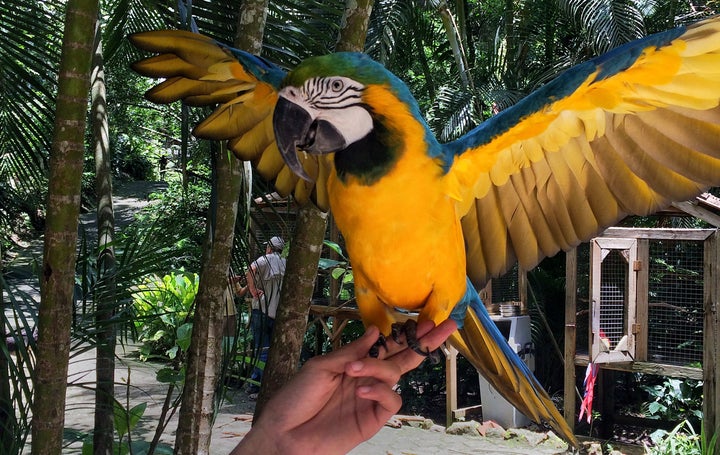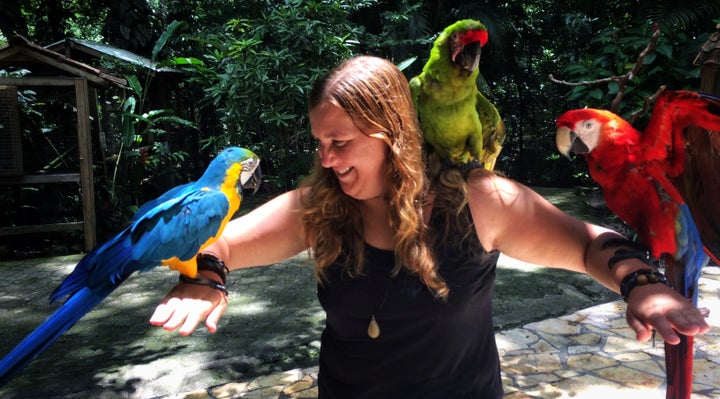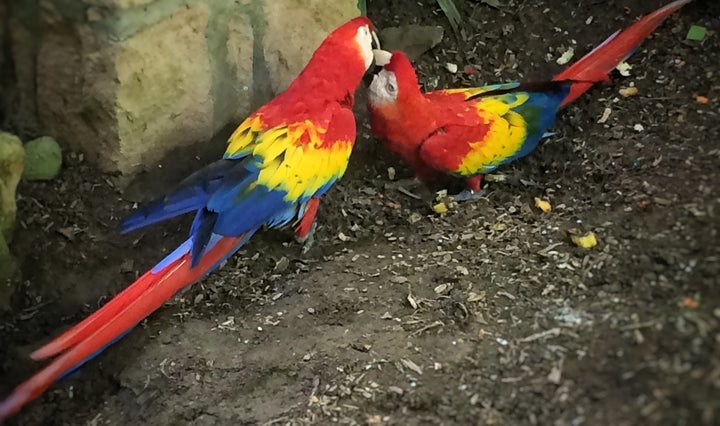
Tucked away in the curve of a tumbling river, just a few kilometres north of the small, cobblestoned town of Copan Ruinas in western Honduras, is something really wonderful.
It's a place where huge, brilliantly plumed scarlet macaws soar through the canopy. Where shy yet daring toucans hop towards visitors, peering curiously this way and that over their almost comically oversized beaks. Where you can swim in a natural pool to the raucous cries of parakeets and parrotlets echoing in the jungle around you.
This place is called Macaw Mountain, and it needs to be on your itinerary for Central America.

Known to the locals simply as Parque de Aves, the Bird Park, Macaw Mountain is both a tourist attraction and a vital part of a growing conservation effort across Honduras to protect rare and endangered parrots. The park is primarily funded through visitor entry fees and the gift shop and restaurant (along with some really good coffee), and the funds raised are used to support the breeding and wild release programs.
The Scarlet Macaw is the national bird of Honduras, and it was once found all through the forests and mountains of Central America. Indeed, the local Mayan ruins (confusingly also called Copan Ruinas, the same name as the town) are famous for their brilliant carvings of scarlet macaws found on many of the temples and plazas. Even the ball court, the famous location of the to-the-death ball games played in most sizable ancient Mayan cities, is decorated in huge carvings of scarlet macaws. But the wild population has been dropping fast, especially over the last century, as the twin scourges of habitat destruction and poaching take their toll.
Macaw Mountain is fighting this through its breeding and wild release programs, and thanks to their efforts you can once again see stunning wild scarlet macaws soaring over the ruins at Copan.
Macaw Mountain is unique among wildlife parks in this part of the world, because of it's focus on wild release. The birds are not at the park simply for the viewing pleasure of tourists - they're there to be rehabilitated, educated, and eventually released into the wild to live as they should.
Most of the birds at Macaw Mountain were rescued or donated by people unable or unwilling to look after them. When the government of Honduras apprehends poachers with birds destined for the international black market, usually captured from the Moskitia, a wild and sparely inhabited region in eastern Honduras, the birds are sent to Macaw Mountain. Similarly, if any birds are confiscated from owners who are found to own them illegally, or who are mistreating them, they're sent to the reserve. Birds are also donated by private owners, usually people who want the best for their birds and didn't quite understand what they were getting into when they became an owner. Unlike a dog or cat, a pet macaw can live up to 100 years in captivity, and they require constant stimulation to keep these highly intelligent animals from becoming bored and stressed. Many people don't understand the commitment they are making with the purchase of a pet parrot, or simply become unable to give it the care it needs as they enter old age themselves.
Some of these birds arrive at the reserve in pretty bad shape, and it's actually pretty confronting to see some of the new arrivals as you wander the grounds of the reserve. Stressed macaws develop the habit of pulling out their own feathers, and some have major bald patches. They can continue this habit for a long time after the stressors disappear, and it's only with care and gentleness that they regain their normal behaviour. One of the birds I met had had its tail and one wing cut off by poachers. It's tail is now growing back, and it's learning to get around with just one wing - luckily, macaws are birds that climb and scramble as much as they fly, so this one should do ok. The carers at the sanctuary make careful decisions about which birds will enter the wild release program. Some are simply too badly damaged, or have been around humans for too long to make it in the wild. These birds will be loved and looked after by the sanctuary staff for good, and they might enter the breeding program too, especially if they're younger birds.
Wandering through the large, walk-in aviaries in the idyllic jungle setting is a simply wonderful experience, and in addition to the macaws you'll find beautiful toucans, noisy green parrotlets, sedate and majestic owls and dozens of other species, most native to the area and many endemic. But the crowning glory of Macaw Mountain is its interactive area. It's here that the birds who are more used to human contact hang out, with no cages or restraints of any kind.

Stand in the centre of this area, and you'll be surrounded by scarlet macaws, blue and gold macaws, mealy Amazons, Buffon's macaws, Hahn's macaws, and other species, all keenly hanging out for meal time and all happy to be peered at and admired. The handlers might ask if you'd like a photo with the birds. Prepare yourself - this means having three or four of these giants birds perched on your shoulders, arms and even head! The ones who will be handed to you are very used to human contact and you're not doing them any harm by hanging out with them - in fact, you're keeping them entertained, and as mentioned above these intelligent animals need constant entertainment to stay happy. Some of them will even speak. Try out "Hola, guapa," - hello, pretty - and see what response you get. Chatting to the handlers, it's obvious they're filled with love and respect for these beautiful birds, who are all well looked after.
Macaw Mountain is one of the absolute highlights of Honduras and in Central America. It's a unique place of conservation, beauty and care, and you should definitely add spending some time with these gorgeous birds to your Central America itinerary.
Need to Know
Macaw Mountain is located about 3km north of the village of Copan Ruinas in Eastern Honduras. To get to Copan Ruinas, you can take a bus or shuttle from most backpacker hotspots in Guatemala, or you could duck down by bus from Roatan or San Pedro Sula in the north. Once in town, it's a fairly easy 2-3km walk, or ask any tuk tuk driver to take you to Parque de Aves for about 15 limpira (less than US $1). Entry to the park is a little steep at $10 US (can be paid in $US or limpira), but your ticket is valid for three days and remember all that money goes straight to the birds. Bring your swimwear for the on-site swimming hole in the river, and don't forget your camera.

